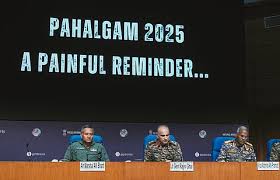India Showcases Strength and Readiness in Detailed Briefing on Operation Sindoor
New Delhi: In a significant display of military coordination and strategic confidence, senior officers from the Indian Armed Forces — the Army, Navy, and Air Force — held a comprehensive joint press conference to present key operational insights and outcomes from Operation Sindoor, the country’s coordinated military response to recent Pakistani aggression.
The briefing was jointly led by Air Marshal AK Bharti, Director General Air Operations (DGAO), and Lieutenant General Rajiv Ghai, Director General of Military Operations (DGMO), who offered an in-depth account of the military engagements, defense systems employed, and the broader implications of the operation.
Advanced Pakistani Weaponry Neutralized
Air Marshal Bharti revealed that Pakistan had deployed advanced, foreign-sourced weaponry during its offensive actions. Among the most notable was the PL-15 air-to-air missile, a sophisticated missile system of Chinese origin, designed for high-precision targeting.
Despite its capabilities, the missile failed to strike its target and was successfully intercepted by Indian defenses.
To substantiate his claim, Air Marshal Bharti shared images and video footage of the debris recovered from the downed missile. “You can see the pieces of it on the screen,” he said, pointing to high-resolution visuals of the missile fragments retrieved by Indian troops.
Turkish-Origin Drones and Munitions Downed
In addition to the failed missile strike, Pakistan also launched multiple aerial threats, including long-range rockets, loitering munitions, and unmanned aerial vehicles (UAVs). Several of these drones, notably Turkish-origin YIHA and Songar models, were used in combat scenarios.
Air Marshal Bharti highlighted that all these aerial threats were effectively neutralized by India’s robust air defense infrastructure, which includes a blend of indigenously developed systems and advanced counter-drone technologies.
Among the standout performers was the Akash air defense system, a testament to India’s growing defense manufacturing capabilities. Bharti credited the sustained policy push, strategic investments, and innovation ecosystem developed over the past decade for empowering the armed forces with home-grown, reliable, and efficient technology.
“Our systems have been battle-tested and proven once again,” he stated, adding that India’s counter-UAS (Unmanned Aerial Systems) capabilities have evolved significantly to deal with modern asymmetric warfare threats.
Confidence in India’s Multi-Layered Defence Grid
Lieutenant General Rajiv Ghai echoed Bharti’s confidence while focusing on ground operations and infrastructure defense. He issued a strong and direct message to any hostile actors contemplating attacks on Indian soil.
“Targeting our airfields, logistics hubs, or strategic installations is far more difficult than imagined,” Ghai said. “There are multiple layers of security, and even if one is breached, the next one will catch you.”
Using a vivid metaphor drawn from cricket, Ghai referenced Indian cricket legend Virat Kohli’s recent retirement and alluded to an old Ashes proverb:
“Ashes to ashes, dust to dust, if Thommo don’t get ya, Lillee must.”
Expanding on this analogy, he said that much like the famous Australian bowling duo, where one or the other would inevitably dismiss the batsman, India’s multi-layered defense network ensures that any incoming threat will be intercepted by at least one of the defensive systems in place. “Even if you cross one level, the next will stop you,” he said emphatically.
Continued Vigilance and Future Preparedness
The military leaders emphasized that numerous aerial threats had been detected and destroyed over the past week, highlighting the state of high alert and combat readiness maintained across all branches of the armed forces.
Operation Sindoor, according to the briefing, served as a strategic deterrent and demonstration of India’s defense preparedness in the face of escalated threats.
It also marked an important moment in joint force operations, showcasing synergy among the Indian Army, Navy, and Air Force in handling a multi-domain conflict scenario.
The briefing concluded with the assurance that India remains fully prepared to protect its sovereignty and respond decisively to any attempts at destabilization.
The officers reaffirmed that national defense mechanisms are continually upgraded, integrating both indigenous innovation and global best practices to stay ahead of evolving threats.
The joint military briefing on Operation Sindoor served as a powerful reminder of India’s evolving military strength, technological self-reliance, and unwavering commitment to national security.
It sent a clear signal to adversaries: India’s defences are not only alert but also capable, resilient, and ready.

